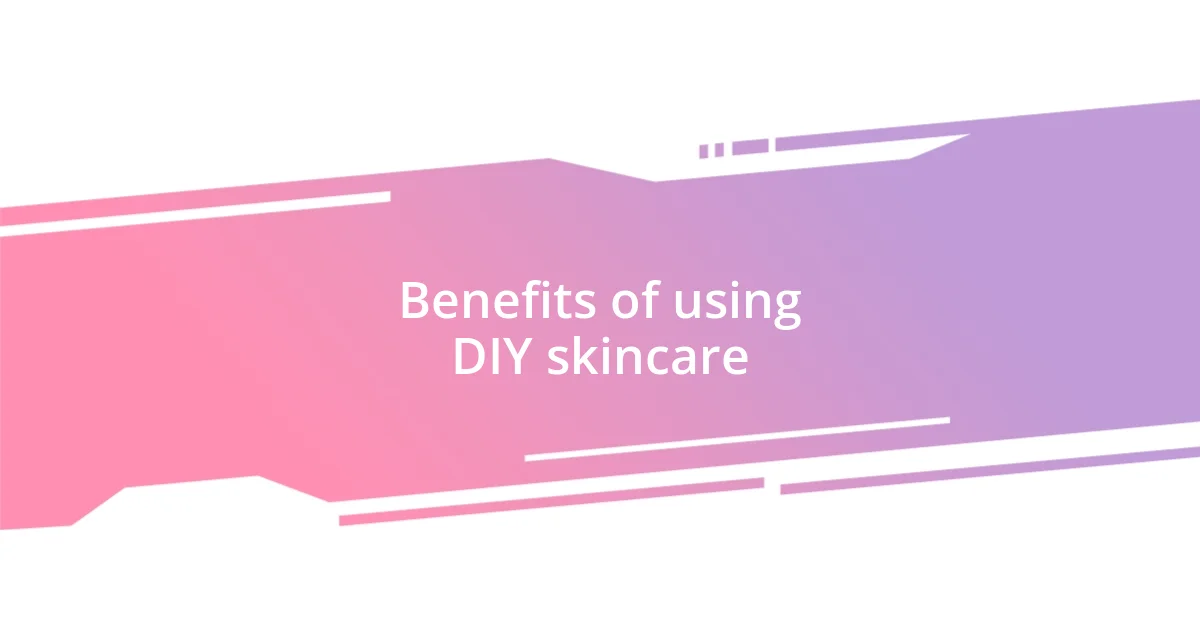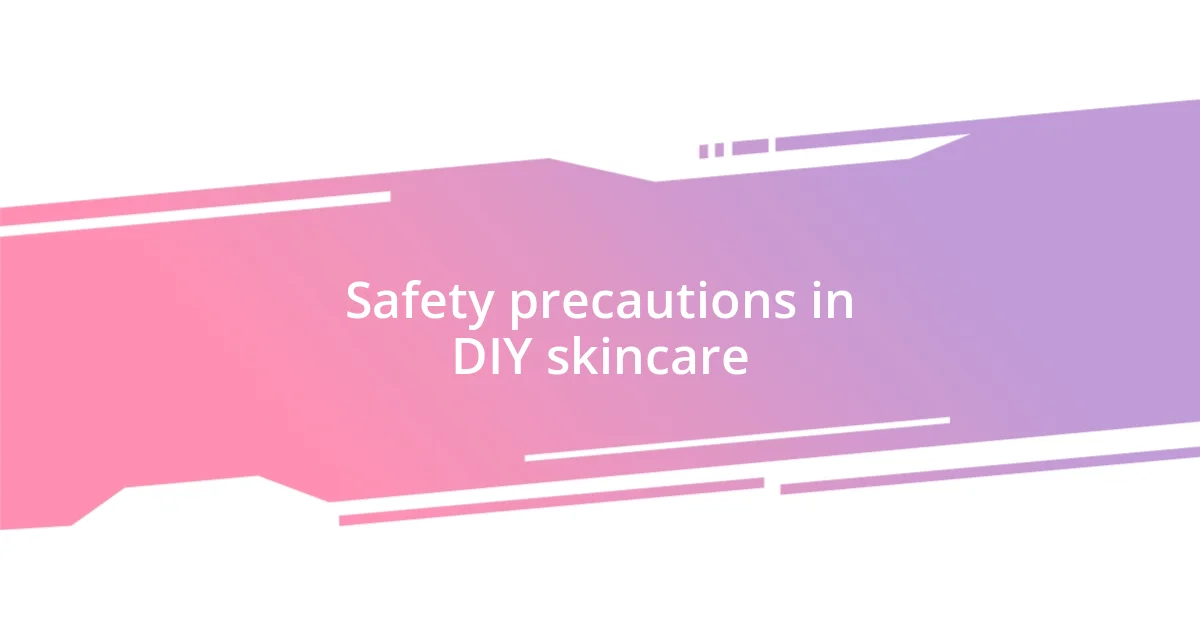Key takeaways:
- DIY skincare offers personalization, cost-effectiveness, and empowerment, allowing individuals to create tailored solutions using natural ingredients.
- Essential ingredients like coconut oil, aloe vera, and honey provide various benefits, enhancing skin health and nurturing properties in DIY recipes.
- Safety precautions such as patch-testing, maintaining hygiene, and monitoring ingredient freshness are crucial for successful DIY skincare experiences.

Introduction to DIY skincare recipes
There’s something incredibly satisfying about creating your own skincare products. I remember the first time I mixed up an avocado face mask in my kitchen, feeling like a mad scientist with all those natural ingredients. It made me curious: could something so simple be just as effective as commercial options filled with mysterious chemicals?
Exploring DIY skincare recipes allows for an authentic connection to the ingredients I use. I often think back to the first time I used honey in my routine; it transformed my skin and my perception of what skincare could be. Isn’t it fascinating how nature provides so many options that not only nurture our skin but also engage our senses?
As I delved deeper into this world, I felt empowered by the knowledge that I could control what went on my skin. The sense of creating something tailored to my needs made me wonder how many people realize they have the potential to personalize their skincare journey. Have you ever thought about the ingredients you slather on daily? This exploration can be both liberating and enlightening.

Benefits of using DIY skincare
The benefits of using DIY skincare are profound and often surprising. When I first started blending natural oils and extracts, I felt an immediate bond with my skin that I hadn’t experienced before. There’s a unique sort of joy in knowing precisely what’s going into each concoction; it’s freeing to escape the manufactured world of commercial products and embrace ingredients straight from nature.
Here are some key advantages I’ve noticed:
– Personalization: I can tailor each recipe to address my skin’s specific needs, whether it’s hydration, exfoliation, or soothing irritation.
– Cost-Effectiveness: DIY skincare can be less expensive than high-end brand products, allowing me to invest in quality ingredients without breaking the bank.
– Creative Outlet: It’s not just about skincare; crafting these recipes has become a fun, creative hobby. I love experimenting with scents and textures!
– Natural Ingredients: I feel a great sense of relief knowing I’m using pure, chemical-free ingredients, which has made my skin healthier and happier.
– Empowerment: Each successful recipe I create reinforces my confidence in my ability to care for my skin naturally, proving that I don’t need to rely on store-bought solutions.
I still remember the excitement of formulating my first facial oil blend with jojoba and lavender. The moment I applied it, I felt both thrilled and empowered, knowing I was nurturing my skin in a way that felt right for me. It’s experiences like this that remind me how rewarding DIY skincare can truly be.

Essential ingredients for DIY recipes
When it comes to creating effective DIY skincare recipes, having the right ingredients is crucial. For instance, I always keep coconut oil on hand; its moisturizing properties have transformed my dry skin into something much softer and more supple. During those winter months, I’ve found that a simple blend of coconut oil and essential oils can work wonders, not only hydrating but also leaving a lovely scent that lifts my mood.
Another vital ingredient I cherish is aloe vera. I remember the first time I used fresh aloe gel straight from the plant. It felt incredibly refreshing after a sun-soaked day! Its soothing properties are unmatched, especially for calming irritated skin. You can bet that it’s now a staple in my DIY recipes.
Here’s a comparison table highlighting some essential ingredients and their benefits in DIY skincare:
| Ingredient | Benefits |
|---|---|
| Coconut Oil | Moisturizes skin, antibacterial properties |
| Aloe Vera | Soothes irritation, hydrates, promotes healing |
| Honey | Natural humectant, antibacterial, brightens skin |
| Jojoba Oil | Balances oil production, non-comedogenic |
| Tea Tree Oil | Antibacterial, anti-inflammatory, great for acne |

Popular DIY skincare recipes
I’ve dabbled in quite a few popular DIY skincare recipes, but one that stands out is a simple honey and oatmeal mask. The first time I slathered it on, I was taken aback by how calming it felt. Honey’s natural humectant properties combined with oatmeal’s gentle exfoliation left my skin feeling both soft and nourished. Have you ever experienced a product that feels like a hug for your face? That’s exactly what this mask delivers!
Another fan-favorite in my DIY repertoire is the classic sugar scrub. I vividly remember the first time I made one using brown sugar and olive oil. The sugar acted as a natural exfoliant, while the olive oil infused my skin with moisture. It was invigorating to scrub away the week’s dead skin! Plus, there’s something oddly satisfying about creating your own spa treatment at home, wouldn’t you agree?
Lastly, I can’t overlook the benefits of my beloved avocado face mask. When I blended ripe avocado with a splash of lemon juice, I barely contained my excitement. The richness of the avocado paired with the bright zing of lemon was a game-changer for hydration and radiance. I remember applying it while lounging on my couch, feeling like I was pampering myself in a five-star spa. Have you ever treated your skin to such a nourishing experience? It’s moments like these that remind me just how delightful and fulfilling DIY skincare can be.

Tips for successful DIY skincare
When embarking on your DIY skincare journey, don’t skimp on quality. I learned this the hard way after trying a budget essential oil that left my skin irritated instead of rejuvenated. Now, I invest in high-quality ingredients, which not only improve the efficacy of my recipes but also make the whole process more enjoyable—there’s something about opening a beautifully packaged, pure oil that feels like a treat!
Another valuable tip I’ve picked up is to always patch-test new ingredients. The first time I skipped this step, I ended up with redness that lasted for days, which was quite the buzzkill! Now, I always test a small area of my skin before applying a new concoction all over my face. It’s a simple precaution that saves me from unnecessary mishaps and boosts my confidence in using the DIY products I create.
Lastly, don’t forget the importance of measurements. I once boldly tossed together a mixture of shea butter and cocoa powder, thinking I’d master the perfect lip balm on my first try. Spoiler alert: it turned into a gritty, unappetizing mess! Now, I follow recipes closely, adjusting a single ingredient at a time, which helps me understand what works best for my skin. Have you encountered similar mishaps? Trust me, the journey of discovering what your skin loves takes practice and patience!

Safety precautions in DIY skincare
When it comes to DIY skincare, safety is paramount. I remember the first time I mixed a scrub that included essential oils; I was so excited to use it that I didn’t consider the possibility of skin sensitivity. After applying it, my skin reacted negatively, leaving me with a painful burn that took days to heal. This taught me the hard way that not all natural ingredients are universally safe, and it’s essential to research potential irritants or allergens in your recipes.
Another crucial precaution I’ve learned is about hygiene. I still recall when I didn’t properly sterilize my mixing tools, which resulted in a minor breakout—definitely not the glamorous outcome I was hoping for! Always ensure that your hands, dishes, and containers are clean when preparing your skincare products. This simple step can significantly reduce the risk of contamination and keep your skin healthy and glowing.
I also can’t stress enough the importance of being aware of expiration dates and storage conditions for your ingredients. One time, I stored a homemade mask in a jar at room temperature, thinking I’d remember to use it within the week. By day four, I opened the jar and was greeted by an unpleasant odor. It struck me then how quickly natural ingredients can spoil. Keeping track of how long you’ve had your mixtures and storing them properly will not only extend their shelf life but also keep your skincare routine safe and effective. Have you ever thought about how the freshness of your ingredients impacts your skin? It’s something worth considering on your DIY journey!














